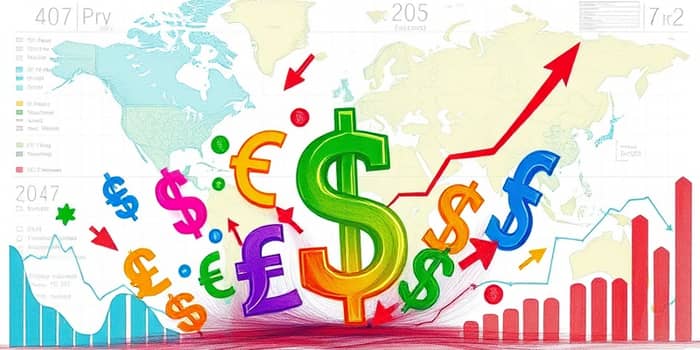
In a hyper-connected global economy, the ebb and flow of exchange rates shape the financial fortunes of multinational corporations. Even when operations run smoothly, sudden currency moves can dramatically alter reported results. Understanding and mastering these dynamics is crucial for business leaders, investors, and treasury teams seeking stability and growth.
The foreign exchange landscape has been marked by exchange rate volatility risks that intensified as the US dollar surged to multi-year highs in 2024 and 2025. Central bank rate hikes, shifting monetary policy stances, and geopolitical tensions have all fueled rapid currency swings. Investors and executives alike have found that predictability in foreign exchange markets has become a scarce commodity.
Developed and emerging market currencies diverged further, creating opportunities for some and headwinds for others. For US-based multinationals, a strong dollar meant shrinking overseas profits once translated back into dollars. Conversely, companies headquartered in Europe or Asia could see their dollar-denominated earnings expand. This dynamic backdrop underscores why long-term revenue projections require more robust scenario planning.
When foreign revenues, expenses, assets, and liabilities are consolidated, they must be translated into the parent company’s reporting currency. Under IFRS and US GAAP, this process gives rise to translation gains and losses, which appear on consolidated financial statements. A strengthening home currency compresses the reported value of overseas operations, while a weakening currency inflates it.
These translation effects can create misleading trends in quarter-on-quarter or year-on-year earnings. A business may show flat operational performance, yet reported profits swing sharply simply due to exchange rate moves. As a result, many firms now disclose both GAAP results and FX-adjusted constant-currency growth in their earnings releases to offer clearer insights into underlying performance.
US technology giants have reported reduced contributions from overseas markets in recent quarters, attributing part of the shortfall to a robust dollar that dilutes revenue earned in euros, yen, and other currencies. By contrast, European exporters enjoyed an earnings boost as the euro weakened, making their products cheaper abroad and translating to higher home-currency returns.
In emerging markets, India’s manufacturing hubs faced squeezed margins when the rupee weakened against the dollar, pushing import costs of critical components higher. Meanwhile, some Latin American firms that earn primarily in dollars saw their local earnings surge in peso terms, temporarily inflating profits but raising questions about sustainability once currencies stabilize.
Effective currency risk management combines financial hedging and operational tactics. Many multinationals purchase forward contracts, options, and swaps to lock in exchange rates, though these instruments carry premium costs and may not fully shield against prolonged trends. Others adopt natural currency hedging methods by aligning costs and revenues in the same currency, reducing net exposure.
Under IFRS and US GAAP, subsidiaries’ financials are translated at current rates for income statements and historical rates for equity accounts. The difference flows into other comprehensive income, impacting shareholders’ equity without hitting the income statement directly. This accounting nuance can mask true operational volatility, prompting demand for supplemental disclosures such as risk-adjusted financial metrics.
Looking ahead, geopolitical tensions, divergent central bank policies, and lingering supply chain disruptions are likely to keep currency markets on edge. The WTO and major institutions warn that unchecked volatility could become a systemic challenge, affecting everything from import bills to global trade balances.
For investors, currency swings add an extra layer of uncertainty to equity valuations and bond returns. While broader market indices may not always track currency moves, individual company earnings often do. Analysts increasingly model multiple currency scenarios, recognizing that a single rate shift can swing profit estimates by double-digit percentages.
As multinationals navigate the turbulent waters of global finance, mastery over currency dynamics has become a core competency. By blending sophisticated hedging programs, operational adjustments, and dynamic treasury management, companies can transform volatility from a threat into a strategic advantage. For executives and investors alike, the challenge lies not in predicting every rate move, but in building resilient systems that thrive across exchange rate cycles.
References













